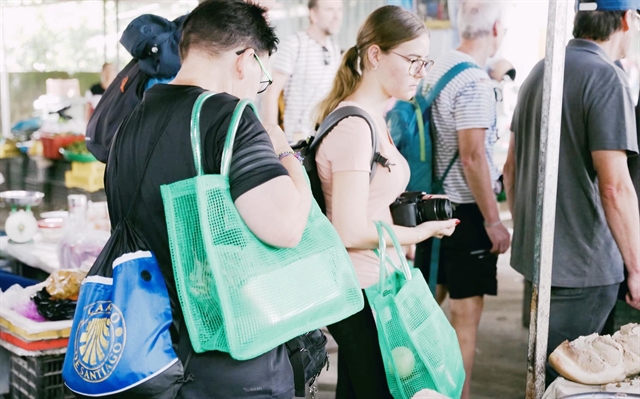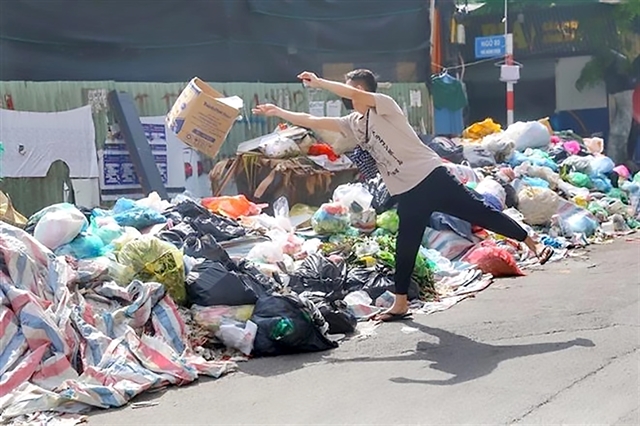 Society
Society

 |
| A pile of garbage on Hà Nội's Hoàng Ngân Street. — VNA/VNS Photo Tuấn Đức |
HÀ NỘI — A recent report indicates a concerning uptrend in plastic waste across provinces and cities in Việt Nam, with HCM City and Hà Nội emerging as the primary culprits.
The findings, a collaborative effort between the World Wide Fund for Nature in Việt Nam, the Ministry of Natural Resources and Environment, and the Việt Nam Administration of Seas and Islands, shed light on the plastic waste situation in Việt Nam for 2022, Tiền Phong (Vanguard) newspaper reported.
In 2021 alone, the country was discarding over 8,000 tonnes of plastic waste daily, totalling around 2.93 million tonnes annually. This marks a significant increase from the 2.7 million tonnes recorded in 2018 and 2.83 million tonnes in 2019.
According to the report, the volume of plastic waste generated in urban areas is 1.6 million tonnes, while the remaining 1.3 million tonnes are from rural areas.
The Hồng (Red) River Delta and the Southeast region emerged as the plastic waste powerhouses of the nation. Not only do they lead in sheer volume, but they also boast higher per capita plastic waste rates compared to other areas.
In most urban areas, per capita plastic waste generation ranges from 40 to 50kg per person per year. Moreover, coastal provinces and cities also record higher volumes of plastic waste compared to mountainous regions.
Hà Nội and HCM City are the two places with the largest volumes of plastic waste.
HCM City, the most populous city in the country, recorded an average of about 1,068 tonnes of plastic waste per day, while the capital Hà Nội recorded about 738 tonnes per day in 2021.
Developed tourist cities and major economic centres also report higher per capita plastic waste volumes than other cities, such as HCM City, Bình Dương, Ninh Thuận and Quảng Ninh. They dispose of an average of 40-44kg/person/year.
However, these figures have improved compared to those reported in 2019.
According to experts behind the report, the surge in plastic waste is tied to changing social and economic dynamics, as well as shifts in consumer behaviour towards plastic usage. Notably, the prevalence of single-use plastics like utensils and food containers has spiked.
However, despite this concerning trend, the efforts to collect and recycle plastic waste, particularly plastic recycling, remain very low. This discrepancy has led to a significant portion of plastic waste ending up in the environment.
The total amount of plastic waste collected was 2.4 million tonnes, including 1.55 million tonnes from urban areas and 0.85 million tonnes from rural areas.
The imbalance in plastic waste collection rates is striking, with rural and urban areas, as well as provinces and cities across the nation, showing significant variations.
Regions like the northern midlands, mountainous areas, central highlands and the Mekong Delta exhibit lower collection rates compared to others, highlighting the need for more comprehensive waste management strategies, experts said.
Among these, the majority of collected plastic waste is either buried or incinerated, with a relatively low recycling rate.
Among the 2.4 million tonnes of plastic waste gathered, merely 0.9 million tonnes underwent sorting for recycling, of which only 0.77 million tonnes were successfully recycled.
The volume of plastic waste released into the environment due to inadequate collection nationwide was more than 420,300 tonnes.
The release of plastic waste into the environment increases the risk of environmental pollution, impacting human health and biodiversity.
Asserting the gravity of plastic pollution as a pressing global environmental challenge, experts propose three key strategies to curb plastic waste: reducing reliance on nylon bags and disposable plastics; implementing effective plastic collection, sorting, and recycling systems; and fostering awareness and behavioural shifts in plastic usage.
The push to decrease the usage of nylon bags and single-use plastics is particularly crucial.
The research group's findings point out that a significant portion of plastic waste in household garbage comprises nylon bags, plastic packaging, and disposable plastic items that resist decomposition.
In order to execute effective plastic waste reduction measures, they propose a comprehensive approach, encompassing measures like restricting production and usage, imposing levies on non-biodegradable plastic goods, and encouraging eco-friendly consumer choices.
Specific measures such as limiting the distribution of nylon bags and single-use plastics in supermarkets, stores and businesses are proposed. These measures extend to accommodations, tourist destinations and service providers, urging them to limit the proliferation of nylon bags and single-use personal care items.
Households and individuals are encouraged to reduce their consumption of nylon bags and single-use plastics by adopting alternative products and altering their consumption habits.
The research group also advocates coordinated efforts to mobilise governmental, corporate and community resources in combatting the pervasive issue of plastic waste pollution. — VNS




